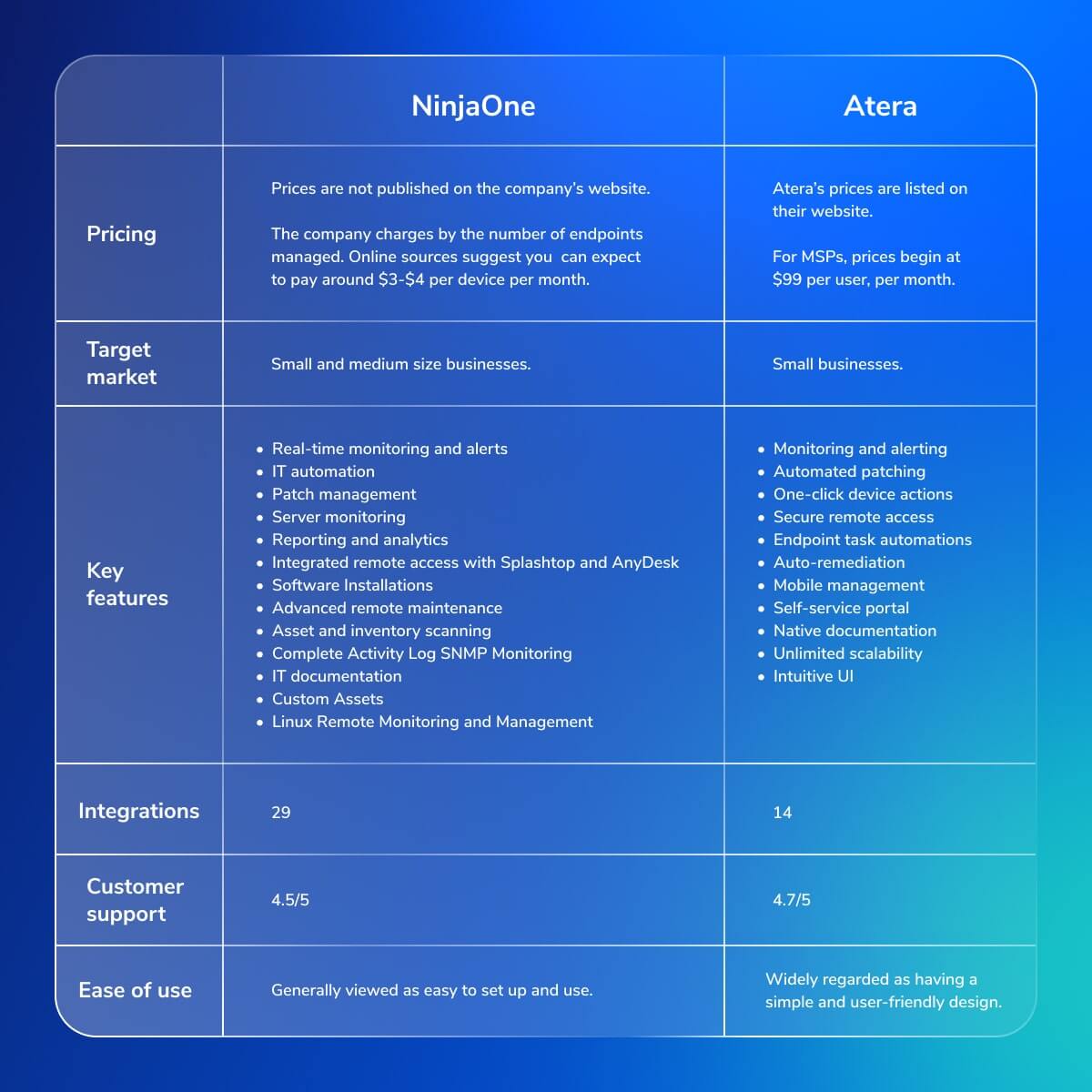If you run an MSP business, choosing a remote monitoring and management (RMM) platform will be a critical business decision. A quality RMM allows you to oversee your customers’ IT environments, remediate issues, and manage everything from patches to software updates.
There are many RMM tools out there, so deciding which one is right for you is a significant MSP challenge. If you choose an RMM that doesn’t really suit your business or your way of working, then it can have a negative impact on your ability to support customers.
In this article, we compare NinjaOne vs Atera. As two of the most popular RMM softwares out there, it’s helpful to see how they’re similar, where they differ, and if there are any other alternatives in the market you should consider for your MSP business (Spoiler alert: There are!).
Let’s get going!
Introducing NinjaOne
NinjaOne provides managed service providers (MSPs) with a wide range of tools to remotely monitor and manage their customers’ IT networks and devices. Founded in 2013 as a purely cloud-based SaaS solution, NinjaOne has solidified its place in the world of RMM software.
The platform allows you to perform all essential RMM tasks, including endpoint management, patch management, software deployment, monitoring, scripting and automation. NinjaOne bills itself as “the world’s easiest-to-use unified IT operations platform”.
Introducing Atera
Atera is an IT management platform that supports MSPs to monitor, manage and automate IT networks. The company was launched in 2011 and it quickly gained reputation among cybersecurity professionals. Like NinjaOne, it is regarded as one of the major players in the RMM sector.
With Atera, MSPs can conduct all manner of RMM activities, including ticketing, managing alerts, patch management, remote device control, helpdesk, reporting and more. The company reports it can “unlock 10X efficiency for IT teams”.
NinjaOne vs. Atera: Head-to-Head Comparison
NinjaOne and Atera share many features in common, but also differ in significant ways. The following NinjaOne vs. Atera comparison table highlights key features, pricing, user experience and more.

NinjaOne vs. Atera: Pros and Cons
To help you evaluate these two RMM tools, we’ve analyzed each platform, as well as independent reviews to highlight the strengths and weaknesses of each.
Pros and Cons of NinjaOne
Advantages of NinjaOne include:
- Easy to use: NinjaOne is widely regarded as an easy to use and manage platform with a relatively simple learning curve. The interface is modern, fast and lightweight, but without sacrificing features or quality.
- Customer support: NinjaOne provides account managers for customers and customer service is generally viewed as strong and responsive.
- Scripting capabilities: NinjaOne’s scripting engine accepts multiple languages, meaning MSPs can script native commands for many different operating systems.
For an MSP, NinjaOne is a no-brainer. Best product I’ve worked with. Can’t think of any scenario where it wouldn’t be appropriate.
On the other hand, when it comes to drawbacks of NinjaOne’s software those include:
- Limited integration options: At the time of writing, there were only 29 integrations with third-party apps. This can cause frustration for some.
- Feature overload: NinjaOne has countless features and controls, and is also regularly pushing out more. While this can be beneficial, some users find the endless stream of features overwhelming.
- User experience: Some customers report that NinjaOne frequently logs them out of their systems, or requires multiple MFA logins each day. This can cause friction and frustration.
Ninja is an affordable, fairly straightforward RMM that I feel is a good fit for smaller implementations. As your client base grows and the diversity of client needs grows you can start to see some of the limitations that Ninja has.
Pros and Cons of Atera
Advantages of Atera include:
- Value for money: Atera is a powerful platform, yet is relatively inexpensive. This is thanks to Atera’s licensing model which charges MSPs per user, rather than the number of devices managed.
- Regular updates: Atera is continually being updated, and many customers praise its clear and consistent roadmap.
- Ease of Use: Atera provides MSPs with lightweight, easy to use tools.
It is great for any MSP that is growing and trying to improve efficiencies. It is not charged per endpoint but per technician so great for a company growing endpoints but not technicians as fast.
Drawbacks of Atera include:
- Better for smaller MSPs: Atera is an excellent option for smaller companies, but as they grow, firms sometimes want a more powerful and comprehensive feature set.
- Limited integrations: Like NinjaOne, Atera provides MSP users with a fairly limited number of integrations – just 15 at the time of writing.
- Learning curve: Some Atera customers report that the learning curve is relatively steep, and they wish there was more documentation to help guide usage.
The licensing is suited more for a small team, or where the ratio of admins to systems is very great. Price increases, plus our team expanding caused us to shop around. We were also unhappy with the patch management that was provided.
NinjaOne vs. Atera: Which Is Right For You?
Deciding between NinjaOne and Atera can be tricky since they share many functionalities in common. Ultimately, your choice of MSP tool will depend on your specific circumstances, budget, customers and other requirements. But the following considerations can help narrow down your choice.
Your MSP Business Size
While both Atera and NinjaOne can be used by companies of any size, Atera is associated with smaller companies. Whether you’re a one-person-band or a small team, Atera offers the simplicity and affordability many SMEs look for.
NinjaOne is a little more feature rich and comprehensive. This means it might be more suited to medium and large MSPs.
Your Budget
In most cases, Atera will be the less expensive option. MSP users pay a flat rate per user per month. With NinjaOne, pricing is calculated depending on the number of devices monitored and can cost around $3-$4 per device. If you’re overseeing several customers’ networks, then this can rapidly add up.
Features Needed
NinjaOne provides MSP users with a larger number of features and controls than Atera. If you need especially granular control of your environment, then NinjaOne could be the way to go. That said, many MSPs stick to the main tools and rarely, if ever, need more advanced features.
Starting an MSP business? Read our guide to MSP marketing
Heimdal®: A Better Alternative to NinjaOne and Atera
Like I said in the beginning of the article, there are other alternatives available to CrowdStrike and SentinelOne that you might want to check out, such as Heimdal®, that brings you everything you need to be well protected in one place.
Heimdal® stands out a comprehensive solution for remote monitoring and management. The platform empowers you with a wide range of RMM features, while offering much more advanced security than NinjaOne and Atera. If you’re offering security as part of your MSP service, then Heimdal® gives you comprehensive tools to keep your customers’ systems protected.
The easy to use tool brings you several key features that make RMM easier, including:
- Network security;
- Vulnerability management;
- Privileged access management;
- Endpoint security;
- Threat hunting;
- Endpoint management;
- Email and collaboration security.
Join Our Partner Program: Partner NEXUS
And moreover, Heimdal®’s Partner NEXUS program is now live and you can join in!

NEXUS (Network of Excellence, Unity, and Safeguarding) is a global initiative tailored for MSPs, MSSPs, distributors and resellers that aims at improving customer security and expanding business opportunities.
Why to join in? As an MSP, MSSP, distributor or reseller, you gain access to a comprehensive cybersecurity kit, user-friendly platform that simplifies security management, and extensive training and support for you to focus on growth and turn the tide against cyberattacks. Moreover, you get the best in cybersecurity:
- The most extensive XDR suite in the market.
- Unified management for simplified control.
- Next-level threat intelligence.
- Reliable and efficient cloud-native architecture.
- Innovative telemetry and responsive capabilities.
- Managed SOC services with exceptional support.
Frequently Asked Questions about NinjaOne and Atera
Comparing NinjaOne vs. Atera? Read our FAQs to find answers to your questions.
Which is better, NinjaOne or Atera?
There’s no simple answer here – the two products do slightly different things, and are aimed at slightly different customer types. That being said, NinjaOne provides more features, and scores marginally higher on customer satisfaction levels. For instance, NinjaOne scores 9.2/10 on TrustRadius, to Atera’s 8.9/10. On review site GetApp, Atera gets 4.5 stars to NinjaOne’s five stars.
Do Atera and NinjaOne offer good cybersecurity tools?
Atera and NinjaOne do not directly market themselves as cybersecurity solutions. That being said, they do offer several features that support cybersecurity management, including patch reminders, alerts and ticket management. However, for more comprehensive cyber risk management, opt for a security-focused solution such as Heimdal.
Are Atera and NinjaOne easy to use?
Yes, both Atera and NinjaOne are well regarded for their clear, easy-to-use interfaces. The platforms are light, and you can manage entire networks from a laptop, tablet or even a smartphone. Both products are fairly easy to learn, although the learning curve on NinjaOne is typically shorter.






